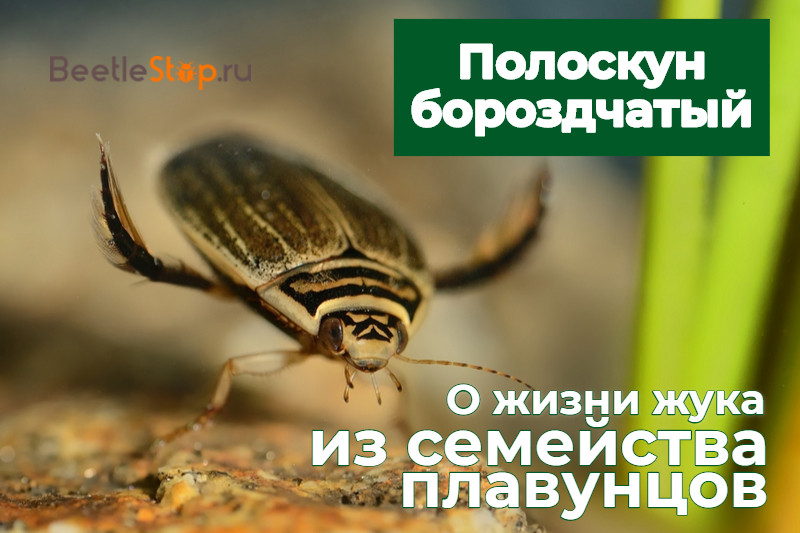Striped furrow - a rapid predator and a beautiful flyer
Plavunsy is the largest family of water beetles, numbering about 4 thousand species. Beetles perfectly adapted to life under water. They have flattened limbs, used for movement, for breathing they capture a supply of air. Stripes or flippers are one of the genera of the family. It includes medium-sized beetles. The type of strip furrow is widespread throughout the world. The aquatic predator lives in large and small bodies of water, in flood fields. Beetle larvae exterminate the offspring of mosquitoes, they are used as biological agents for controlling the number of blood-sucking insects.

Morphological description of the species
Striped furrow (Acilius Sulcatus) is a species from the family of swimmers, the subfamily Dytiscinae, the genus stripes. The body of the beetle is oval streamlined, size 15-18 mm. The head is partially retracted into the prothorax, the eyes are convex, the antennae are filiform, 11-segmented. On the forehead is a drawing of black stripes. Pronotum transverse, with two black bands connected at the edges. The upper side of the body is brown, the lower is black.
Sexual dimorphism
Outwardly, males and females differ in elytra. In males they are smooth, oval, densely covered with black dots. On the front legs there are disc-shaped extensions that are used as suction cups during mating. The elytra of the females is cut by grooves, between the protruding keels are brown hairs.
The forelimbs of beetles are short, adapted to hold prey. Hind legs long, flattened, covered with setae. They are the main swimming tool. Hind tibia and femur black.
Information. In case of danger, the strips emit a poisonous milky white liquid. A caustic substance covers the chest and part of the elytra. Predators lose interest in poisoned prey.
Habitat
The largest number of beetles of the species Acilius Sulcatus is concentrated in northeastern Europe, including Russia. Stripes are found in Asia Minor, northern Africa. They live in Siberia, Primorsky Krai, on the island of Sakhalin, in Japan.
Lifestyle
The strip lives in lakes, reclamation canals, rivers, comes across in small depressions filled with water. Due to its ability to fly, it actively moves in search of food rich reservoirs. The beetle has no preferences in terms of habitat; it is found in ponds with large and small amounts of vegetation. A predatory strip of furrow feeds on small invertebrates. The beetle swims quickly, so it pursues prey, and does not wait in ambush. He preys on tadpoles, fry, water bugs, caddis larvae. Adults hibernate in deep ponds that do not freeze.
Information. For breathing, a strip raises the tip of the abdomen above the water. The captured air supply is located under the elytra.
Reproduction and development
After spring awakening, the beetles begin to mate. In April-May, females lay eggs on plants, stones, moss, and roots located near the water. The eggs are oblong, light yellow. After 2 weeks, larvae with a thin body, a small head and a long neck appear. They pass three ages and molt twice. The development period is 30 days. Adult larvae grow to 30-32 mm. Their body shape is fusiform, with dark spots on their backs.
The prothorax is elongated, simple eyes are located on a small head, allowing you to see in different directions and up. The mandibles are short, sickle-shaped. The three pairs of limbs and the last two segments of the abdomen are densely covered with hairs. Insects swim lifting their abdomen up and fingering. For breathing atmospheric air, the tail section exposes outward, the trachea is filled with oxygen. The greatest number of offspring of strips is observed in early June.
The main objects of hunting: daphnia, nymphs of dragonflies, caddis flies, crustaceans (water donkey), mosquito larvae. Having captured prey, the larvae enter digestive enzymes into its body. After dissolution of the tissues, a nutritious cocktail is absorbed.
By the end of June, the larvae complete their development and are selected on land for pupation. Under a stone or moss, she builds a cradle for a doll. With the help of the back and limbs, an earthen cushion is built, gradually hiding the insect. The case will protect the chrysalis from drying out and external dangers. Ready-made cradle of spherical shape, the size of a cherry. It takes several days to build, at night the larva returns to the reservoir. The pupal phase lasts 10–16 days. Young beetles appear with soft integument. They hide in a hole until chitin hardens. In early autumn, the largest number of strips of furrow. Young growth sets off in search of deep-sea ponds and lakes for wintering.

